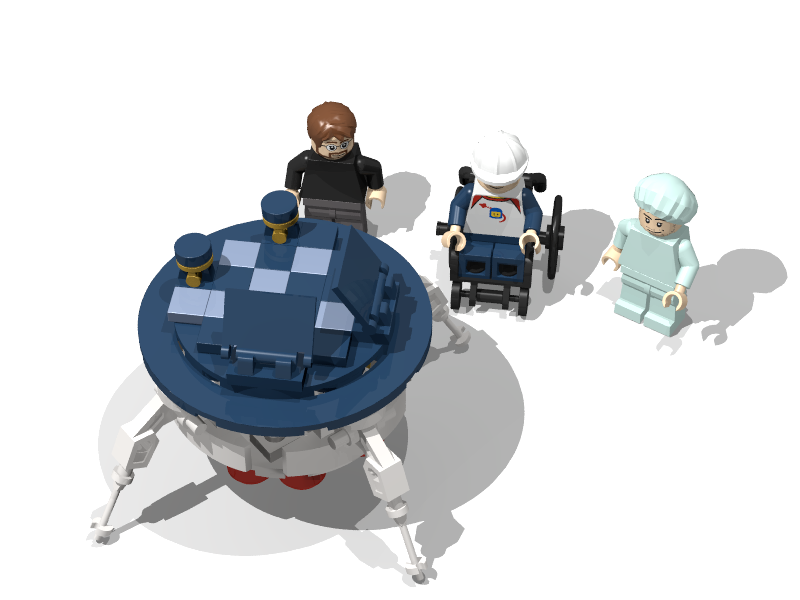Lunar mission "Bereshit" - analysis of the accident, announcement of the launch of the development of the device "Bereshit 2.0"
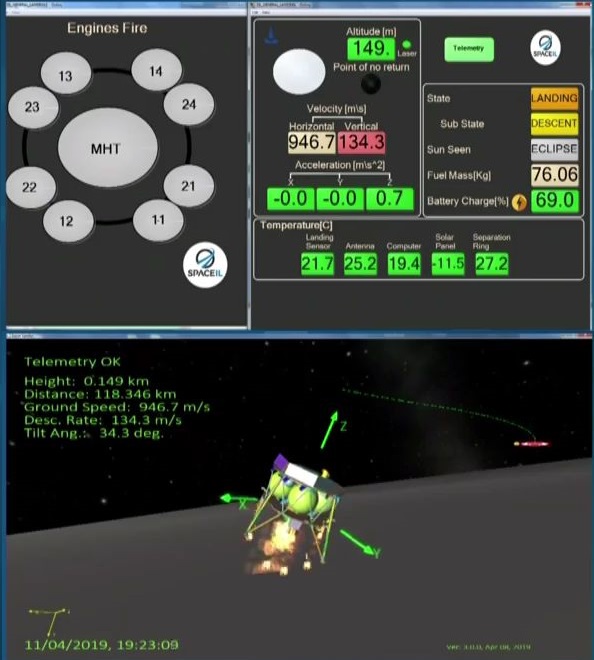
The late evening of April 11, 2019 was the starting point for the launch of a new project, “Bereshit 2.0,” since the accident of the first private device when trying to land on the moon only enraged the engineers and the SpaceIL organization.
Space is cruel, and the moon does not immediately allow itself to sit. But with experience and modern technology, each new attempt becomes more successful.
Previously published materials about the Bereshit mission:
1. Lunar mission "Bereshit" - an online portal with a trajectory simulator and monitoring of current flight parameters .
2. The lunar mission "Bereshit" - a selfie on the background of the Earth .
3. Lunar mission "Bereshit" - engineers at the MCC SpaceIL and Israel Aerospace Industries (IAI) solved the problems .
4. Lunar mission "Bereshit" - the characteristics of the device, a series of maneuvers and the longest way to the moon .
5. Lunar mission "Bereshit" - the fourth maneuver was completed successfully, preparations are underway for entering the lunar orbit .
6. Lunar mission "Bereshit" - the first video from the onboard camera and new photos in outer space .
7.Bereshit lunar mission - eight milestones of success and $ 1 million from the XPRIZE Foundation (subject to a successful landing) .
8. Lunar mission “Bereshit” - on April 4, 2019, the transition to the lunar orbit was completed, ahead of 7 days of flight, 6 maneuvers and 1 landing .
9. The lunar mission "Bereshit": landing-accident-fall on the moon .
2. The lunar mission "Bereshit" - a selfie on the background of the Earth .
3. Lunar mission "Bereshit" - engineers at the MCC SpaceIL and Israel Aerospace Industries (IAI) solved the problems .
4. Lunar mission "Bereshit" - the characteristics of the device, a series of maneuvers and the longest way to the moon .
5. Lunar mission "Bereshit" - the fourth maneuver was completed successfully, preparations are underway for entering the lunar orbit .
6. Lunar mission "Bereshit" - the first video from the onboard camera and new photos in outer space .
7.Bereshit lunar mission - eight milestones of success and $ 1 million from the XPRIZE Foundation (subject to a successful landing) .
8. Lunar mission “Bereshit” - on April 4, 2019, the transition to the lunar orbit was completed, ahead of 7 days of flight, 6 maneuvers and 1 landing .
9. The lunar mission "Bereshit": landing-accident-fall on the moon .
What successes were achieved by the Bereshit mission?
Briefly about the Bereshit mission: 8 years of development, the project cost $ 100 million, 200 volunteer scientists and engineers, 47 days of flight and more than 6.5 million kilometers were overcome, at the start of 380 kilograms of fuel, a forced LEROS 2b engine, 6 onboard chambers , a magnetometer, an array of laser corner reflectors, and 1 landing attempt, in which a 150-kilogram apparatus with 76 kilograms of fuel (hydrazine) in tanks with high speed, far flying the zone of the planned landing, fell to the surface of the moon.
The Bereshit apparatus was in orbit of the Moon and used a magnetometer during landing and transmitted to the MCC some of the scientific data on the magnetic field of the moon.
Now Israel is the 7th country that launched its spacecraft into orbit of the Moon (and held it there for 7 days).
List of countries (their first devices were counted) with devices in orbit of the Moon:
1. Luna-10, USSR, 1966;
2. Lunar Orbiter 1, USA, 1966;
3. Hagoromo, Japan, 1990;
4. SMART-1, ESA, 2005;
5. Chang'e-1, China, 2007;
6. Chandrayan-1, India, 2008;
7. Bereshit, Israel, 2019.
And yet, now Israel is the 7th country that dropped its spacecraft onto the lunar surface (albeit during the landing process, which turned into an uncontrollable fatal crash).
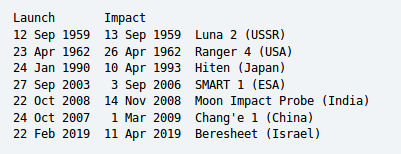
It is assumed that the diameter of the formed crater after falling from 3 to 5 meters. The Bereshit apparatus crashed into the lunar surface at a small angle (~ 8 °), the crater can be elongated.
The cost of the components of the Bereshit device ( picture taken from here ):

The main characteristics of the mission and the lunar vehicle "Bereshit":
- start of the mission: February 22, 2019;
- end of mission: crashed on the surface of the moon at the final stage of landing on April 11, 2019;
- the trajectory of movement to the Moon (in fact, the maximum possible): complex, changeable by performing a series of maneuvers (turning on the engines for several seconds or even minutes) to increase the apogee of its elliptical upholstery after each orbit around the Earth;
- the height of the Bereshit apparatus is about 1.5 meters, a diameter of 2 meters (2.3 meters between landing supports);
- weight 530 kilograms with fuel (fuel weight - 380 kg), 150 kg without fuel;
- main engine: modification of LEROS 2b;
- The main element of the on-board computer: dual-core processor Gaisler HiRel GR712RC;
- Six 8-megapixel cameras Imperx Bobcat B3320C with optics Ruda;
- scientific instruments: magnetometer, array of laser corner reflectors.
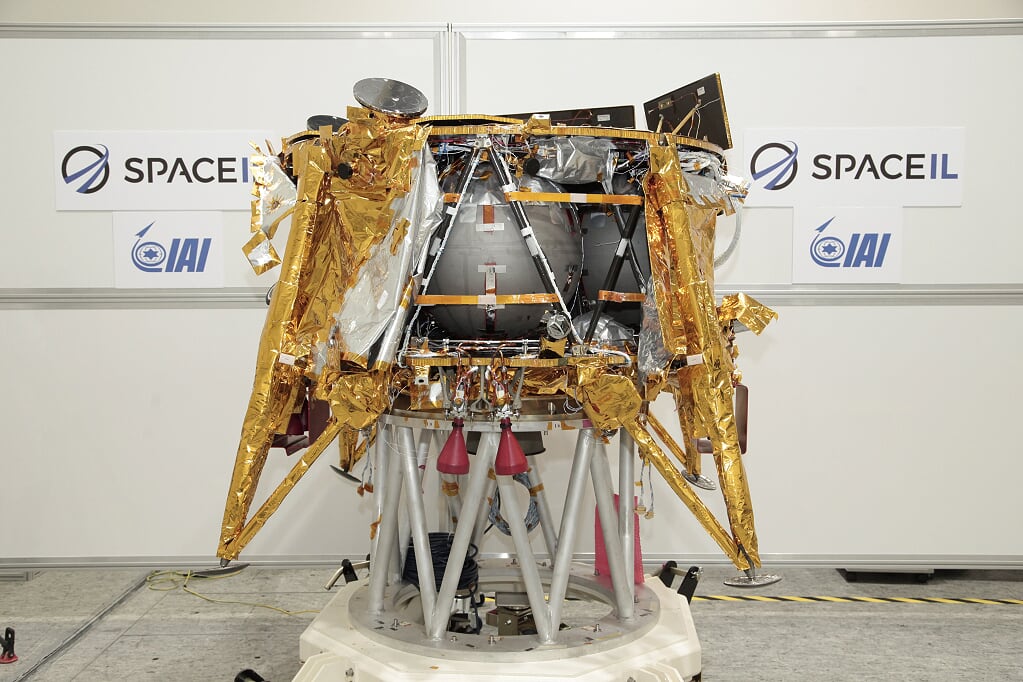
The Bereshit device was developed by SpaceIL organizations, which is supported mainly by private investors, including American tycoon Sheldon Adelson and billionaire Morris Kahn, who are also co-founders of Amdocs (DOX), one of Israel’s largest companies.
It is impossible to send the lunar apparatus into space by the forces and means of only one small private company, but with the help of the international space community, you can turn the idea into a full-fledged project currently being implemented.
Project participants involved in the Bereshit mission:
- a team of young Israeli scientists and engineers from SpaceIL,
- NASA (USA),
- ISA (Israeli Space Agency),
- IAI (Israeli Aviation Industry Concern),
- Spaceflight Industries (USA, organizer of launching the Bereshit spacecraft into orbit),
- SpaceX (USA, rocket carrier Falcon 9),
- the Swedish Space Corporation (Swedish Space Corporation),
- the company Cobham (Sweden),
- the company Ramon Chips (Israel).

After all, SpaceIL is a small organization by world standards, it employs about 200 people, and most of them are volunteer scientists and engineers who "seek to promote the development of technological and scientific progress in Israel."
- end of mission: crashed on the surface of the moon at the final stage of landing on April 11, 2019;
- the trajectory of movement to the Moon (in fact, the maximum possible): complex, changeable by performing a series of maneuvers (turning on the engines for several seconds or even minutes) to increase the apogee of its elliptical upholstery after each orbit around the Earth;
- the height of the Bereshit apparatus is about 1.5 meters, a diameter of 2 meters (2.3 meters between landing supports);
- weight 530 kilograms with fuel (fuel weight - 380 kg), 150 kg without fuel;
- main engine: modification of LEROS 2b;
- The main element of the on-board computer: dual-core processor Gaisler HiRel GR712RC;
- Six 8-megapixel cameras Imperx Bobcat B3320C with optics Ruda;
- scientific instruments: magnetometer, array of laser corner reflectors.

The Bereshit device was developed by SpaceIL organizations, which is supported mainly by private investors, including American tycoon Sheldon Adelson and billionaire Morris Kahn, who are also co-founders of Amdocs (DOX), one of Israel’s largest companies.
It is impossible to send the lunar apparatus into space by the forces and means of only one small private company, but with the help of the international space community, you can turn the idea into a full-fledged project currently being implemented.
Project participants involved in the Bereshit mission:
- a team of young Israeli scientists and engineers from SpaceIL,
- NASA (USA),
- ISA (Israeli Space Agency),
- IAI (Israeli Aviation Industry Concern),
- Spaceflight Industries (USA, organizer of launching the Bereshit spacecraft into orbit),
- SpaceX (USA, rocket carrier Falcon 9),
- the Swedish Space Corporation (Swedish Space Corporation),
- the company Cobham (Sweden),
- the company Ramon Chips (Israel).

After all, SpaceIL is a small organization by world standards, it employs about 200 people, and most of them are volunteer scientists and engineers who "seek to promote the development of technological and scientific progress in Israel."
What happened during the landing of the Bereshit device on April 11, 2019?
In fact, problems with the Bereshit device began almost immediately after the launch.
February 2019:
Sunlight exposure of the device’s position sensors (the sensors were very sensitive to such “dazzle”), which can affect the orientation of the device in space.
Solution: software compensation was performed to process the data from the sensors and reduce their sensitivity, additional multiple checks of new data from the sensors of the device were made.
At the preparation stage, before performing the second engine maneuver, the Bereshit on-board computer unexpectedly rebooted, and the maneuver execution stage was automatically canceled. SpaceIL and IAI engineers began to analyze the situation.
There was a problem on board that limited the maneuverability of the device.
Solution: SpaceIL and IAI engineers fixed the failure in the computer system of the Bereshit device, now the Bereshit device continues its flight to the Moon in the normal mode.
Further, SpaceIL did not announce new malfunctions or problems with the Bereshit apparatus , however, before the lunar maneuvers, the report had such a slide on which there were more than one reboot / failure in the work of the BC - several and even more than the engineers had expected , and because of the harsh space environment.
Problems and solutions that were in space (it turns out there were many reboots of the BC):
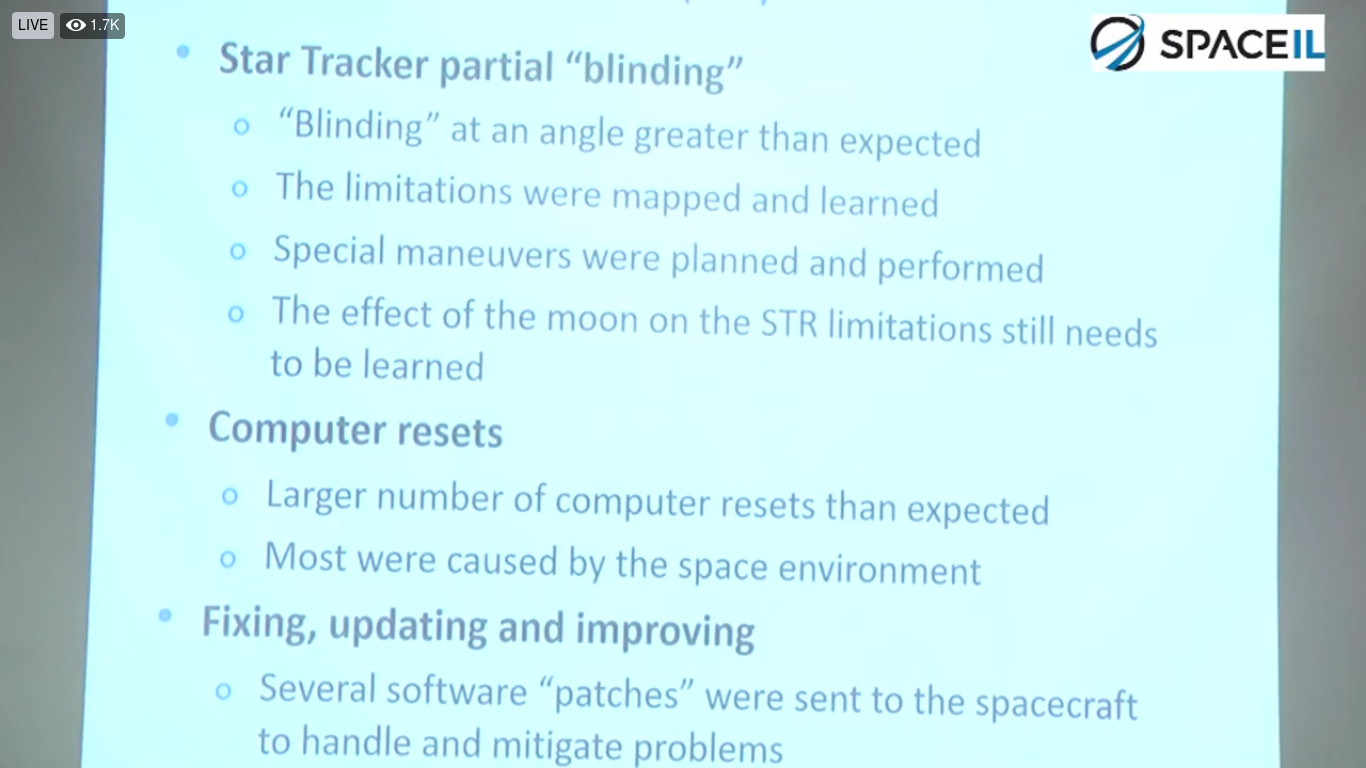
Thus, it could be expected that after 1128 hours of flight (47 days), problems with the internal components of the Bereshit apparatus could become fatal, and their correction is impossible if the elements fail or they work abnormally under severe load and the influence of the space environment.
The landing of the device on the moon is a complex process in which the on-board computer performs a large amount of tasks: controlling the operating modes of the engines, analyzing telemetry and data from sensors (position, altitude, speed, landing, and so on), adjusting the current position of the device according to the landing path and actual coordinates, adaptive fuel consumption, data transmission using a communication system.
And if an emergency situation occurs with one or more sensors during landing, this moment can be compensated automatically if there is a backup circuit, or by restarting (rebooting) the on-board computer system if there is time for this process.
In manual mode and in real time, the engineers at the control center did not control the Bereshit apparatus, the on-board computer landed, after the apparatus exited the "point of no return", when it was only necessary to carry out the landing procedure, the commands of which were received previously by the on-board computer.
But to take into account the situation and compensate for the problems when several elements fail in a cascade, and then due to their failures, the main components of the device (engines, telemetry systems, on-board computer) will turn off - this is also difficult for an apparatus of this level (without redundant control systems ), as practice has shown, is impossible.
What else is known about the hardware and software components of the Bereshit apparatus
- one (1) 430N thrust engine and eight (8) 25N thrust engines. Shunting engines were used when landing to help the main;
- The temperature of the electronics is maintained in the range from -10 ° C to + 40 ° C. Most of the electricity is spent on heating the electronics (no cooling system);
- the on-board computer is one (1), not duplicated;
- the star sensor for orienting the Bereshit device is equipped with a black cone for absorbing third-party rays, however, when the Bereshit device was separated from the satellites after the start, it turned out that the cone was dirty, the engineers coped with this problem, finding out what angles of reflection did not occur and introduced adjustments to the software algorithm for processing data from the sensor (using software patches);
- there were several computer reboots during the flight to the moon;
- control program code, commands and work with the on-board computer - in C language;
- due to the fact that there is only one computer, upon restart all updates (patches) are erased and they need to be additionally downloaded again to the system;
- low data transfer speed: one high-resolution photo (from a 8 Mpx camera) loads 40 minutes;
- DLR (German Aerospace Center) tested the landing mechanism of the Bereshit spacecraft.
SpaceIL Team: Most of them are aeronautics engineers and physicists. But there are some younger members that were trained by the IDF's satellite operations unit.
The Bereshit hardware systems, the failure of which could lead to the abnormal execution of the stages of the landing procedure and the fall:
The engine of the Bereshit apparatus.
The engine of the Bereshit apparatus is a specially adapted (for the Bereshit mission it was modified by shortening the nozzle and increasing thrust) chemical missile unit of the LEROS family (for use on satellite platforms) - LEROS 2b modification on hydrazine (monomethylhydrazine) with a thrust of 45 kgf (441H), which is slightly more than its regular characteristics at 41.5 kgf (407H).
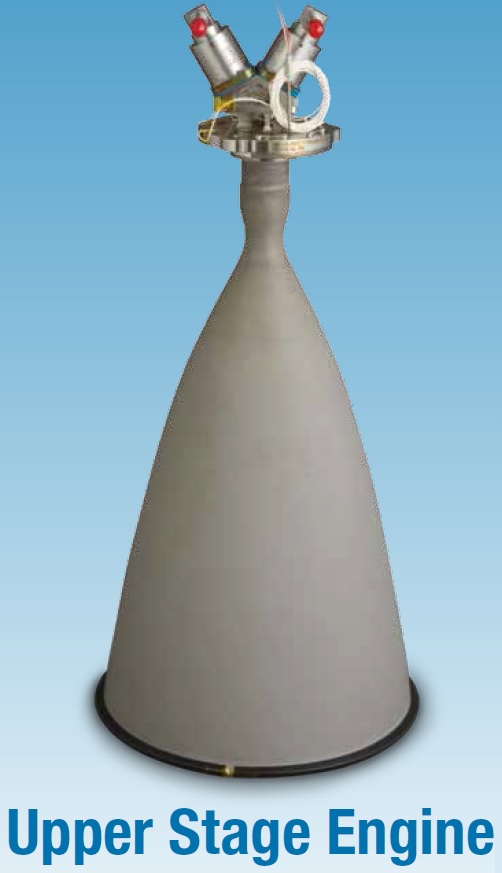
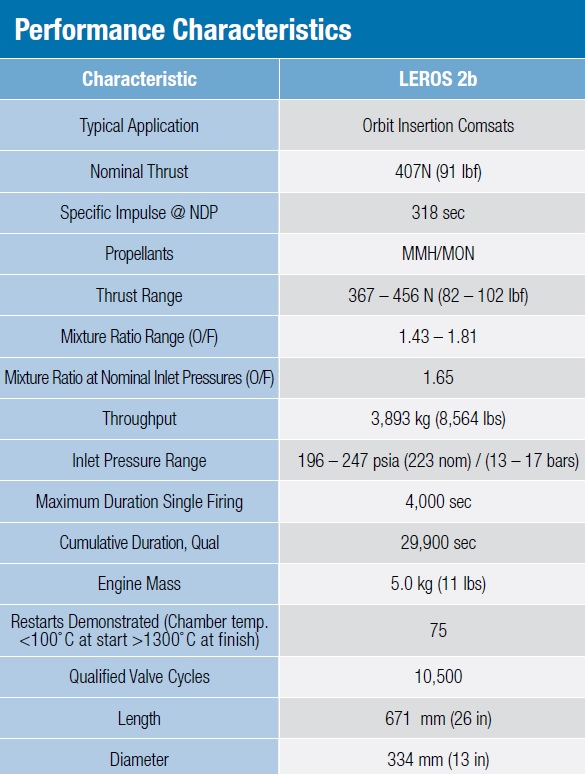
There is an assumption that this engine was not designed for multiple starts and it is not throttled, although during the Bereshit mission there were multiple starts of the main engine for several minutes, and during landing, tens of minutes.
The total thrust of shunting engines is 8 * 25H = 200H (half of the main). That is, when the main engine is turned off, the thrust will drop by three times, which was observed during landing.
Engine shutdowns during landing were also recorded:
Doppler landing-fall curve of the Bereshit apparatus, around 19:19 braking almost stopped:
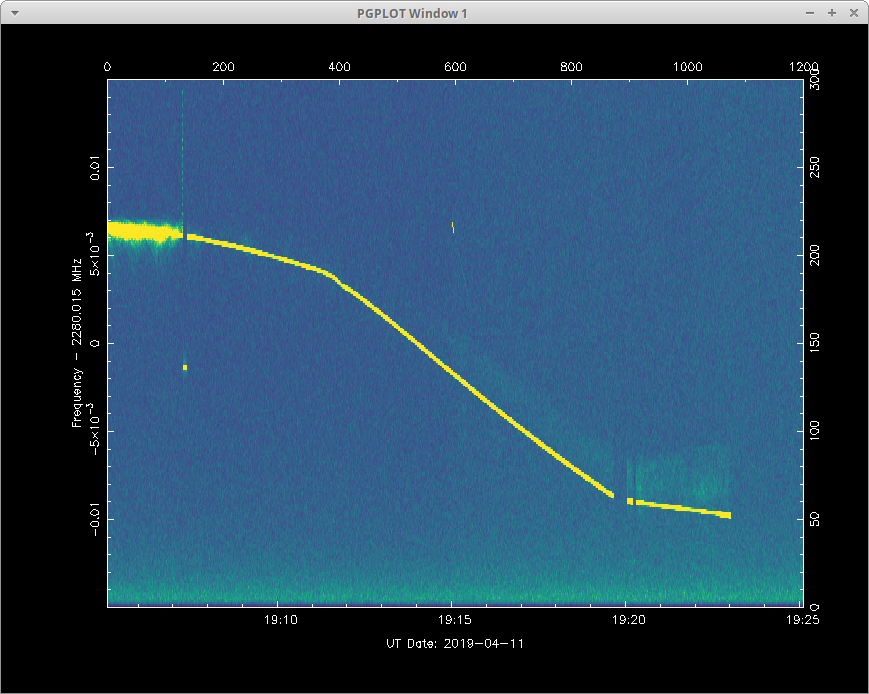
On-board computer.

Cobham Gaisler's HiRel GR712RC processor
as the main element of the onboard computer in the machine 'Genesis' is used a dual-core processor Gaisler HiRel GR712RC company Cobham.
Technologically, the chip is based on LEON SPARC and is manufactured using a unique radiation-resistant silicon technology.
SpaceIL became the first customer of this processorand SpaceIL engineers wrote special software for it before actually delivering and running it on the Bereshit device.
GR712RC is a dual-core processor LEON3FT SPARC V8 . It can operate at frequencies up to 125 MHz in the entire range of military frequencies. This provides up to 300 DMIPS and 250 MFLOPS peak performance. Integrates advanced interface protocols, including SpaceWire, CAN, SatCAN, UART, 1553B, Ethernet, SPI, I2C, GPIO and others. It has high-speed interface buses for external memory SDRAM / SRAM / PROM / EEROM / NOR-FLASH. Proven radiation resistance - up to 300 deg. Low power consumption.
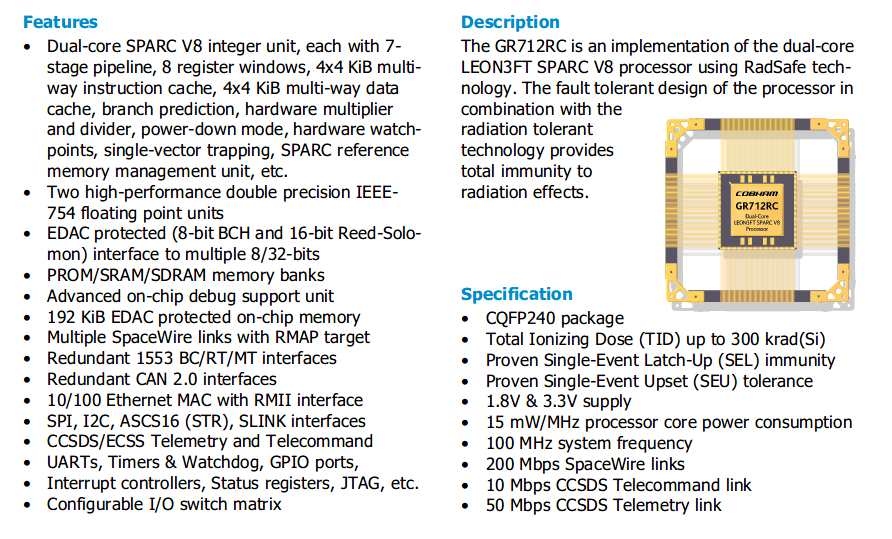

According to updated data - this processor is manufactured using the most common commercially available technology (TowerJazz 180 nm, made in Israel), about the same on which the controllers for electric kettles do. Ensuring joyfulness without interfering with the technology, due to circuitry and topology of elements, which costs an order or two cheaper than if the manufacturing process was developed specifically.
The on-board computer of the Bereshit apparatus had already restarted several times before landing due to the influence of the space environment (radiation, temperature).
TT&C.
The tracking, telemetry and command subsystem (TT&C - tracking, telemetry and command subsystem) system used in this project “hung” two (2!) Times in the final landing stage, although its status was “OK”
Sensors and system components of the Bereshit apparatus in the telemetry data window:
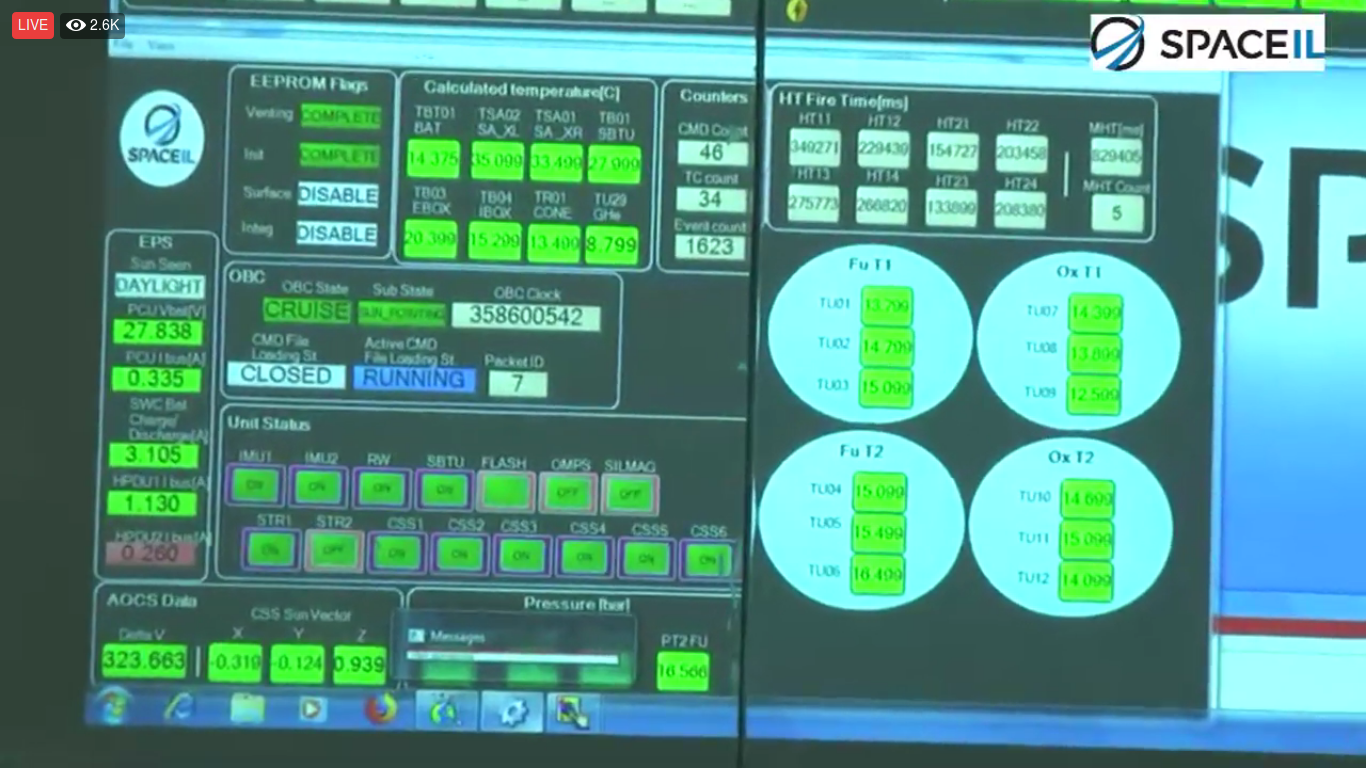
How the telemetry system hung:

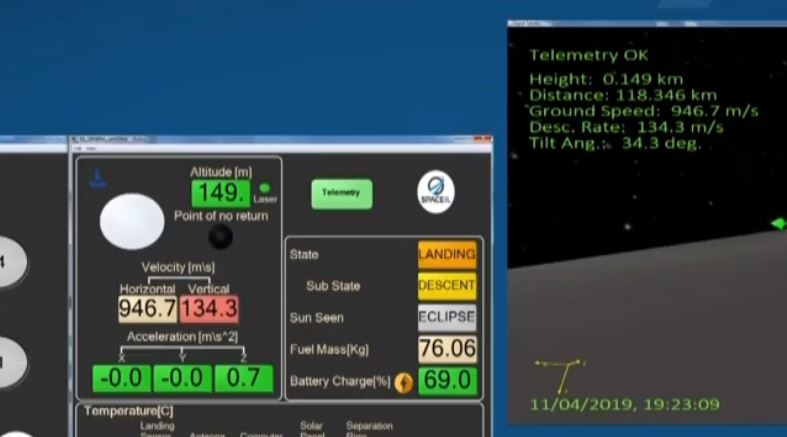
This is what the engineers at the MCC saw during landing, according to the telemetry data:
Normal landing mode:
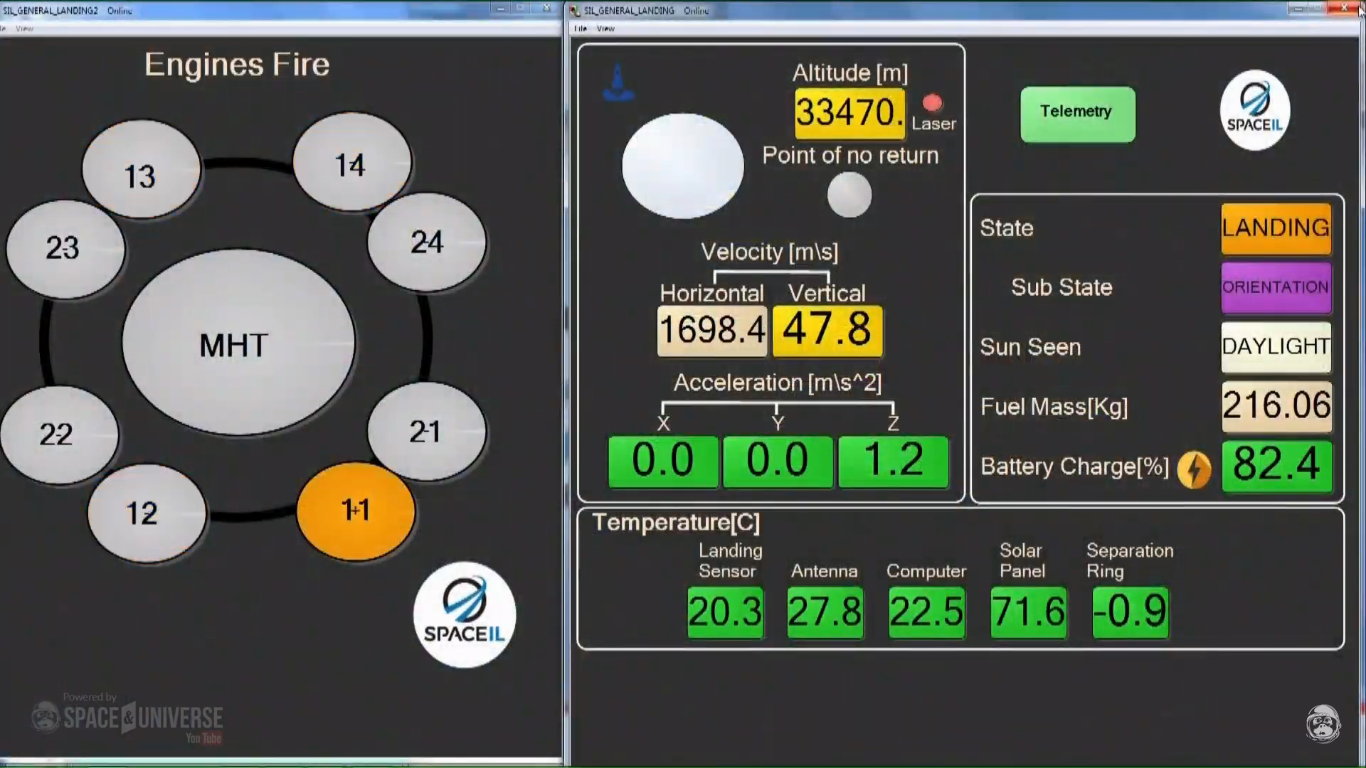
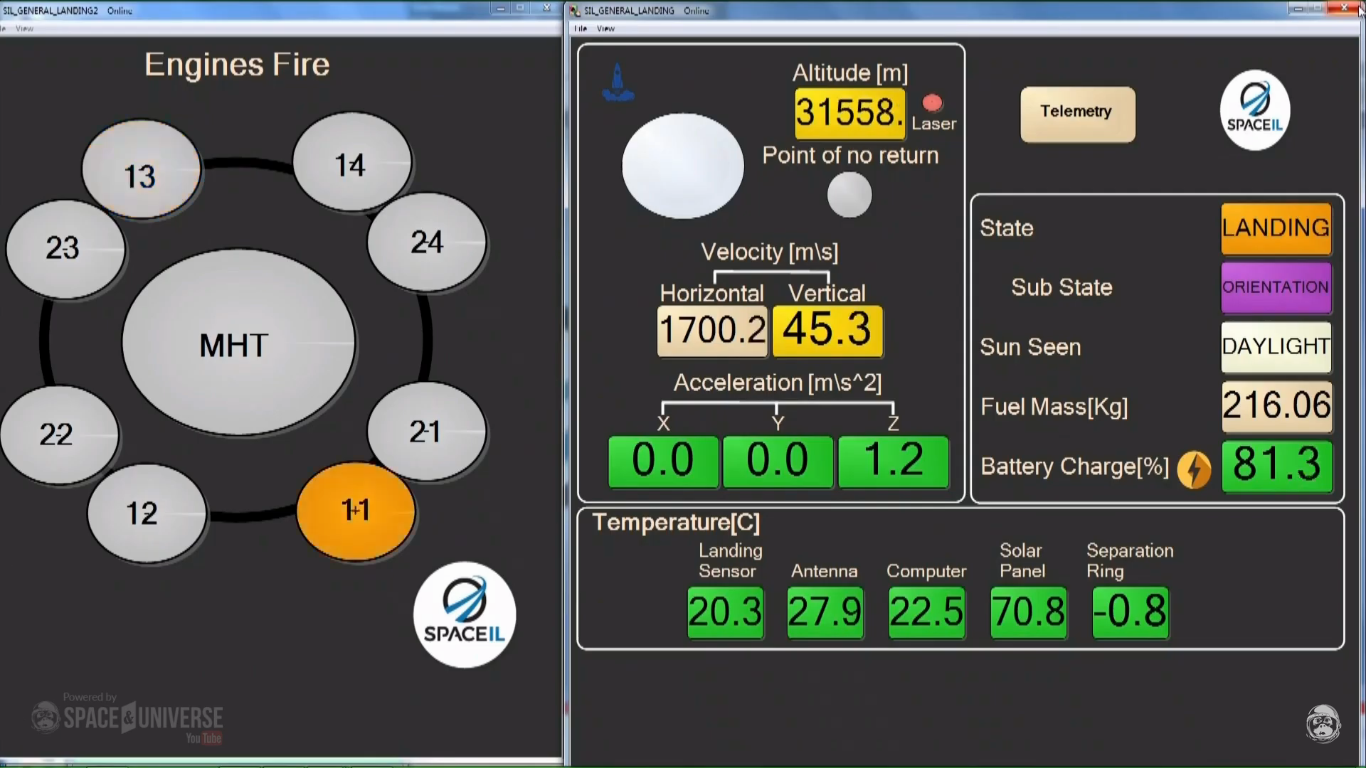

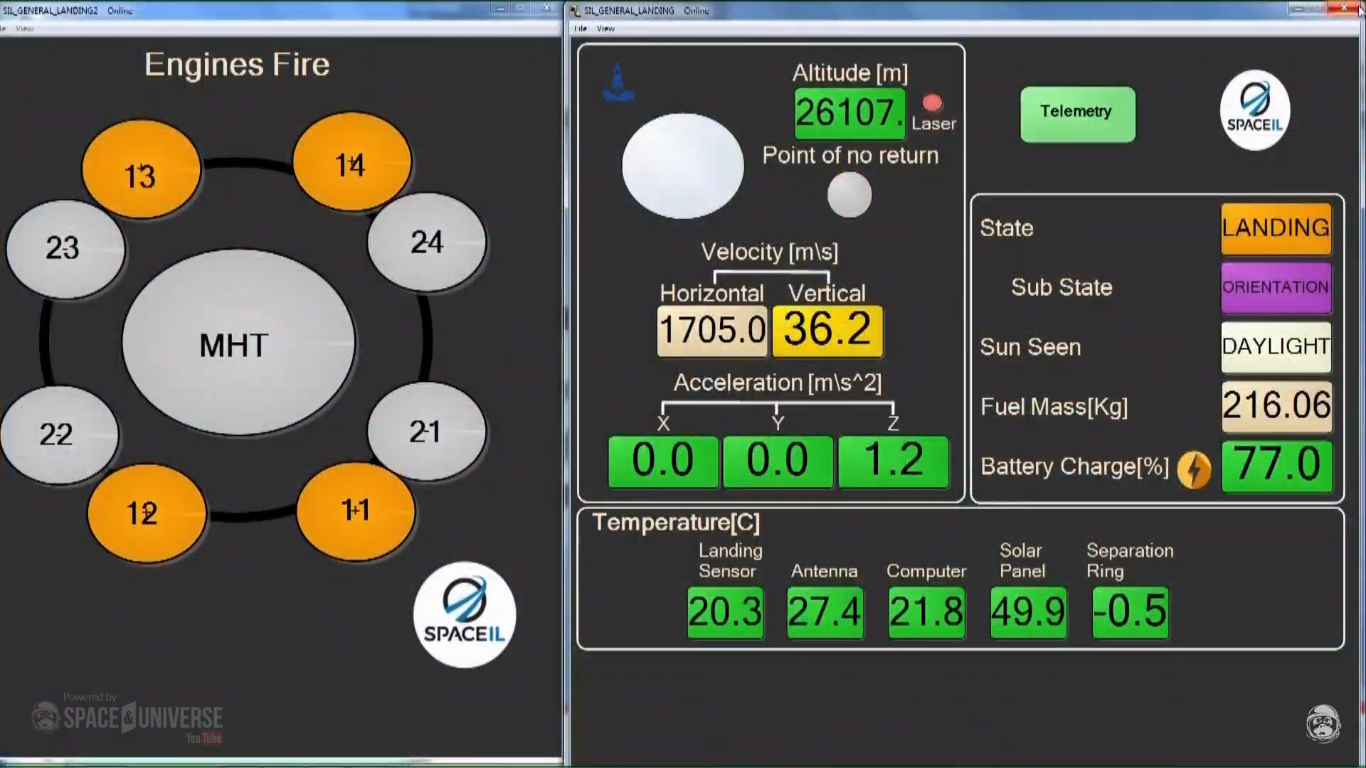
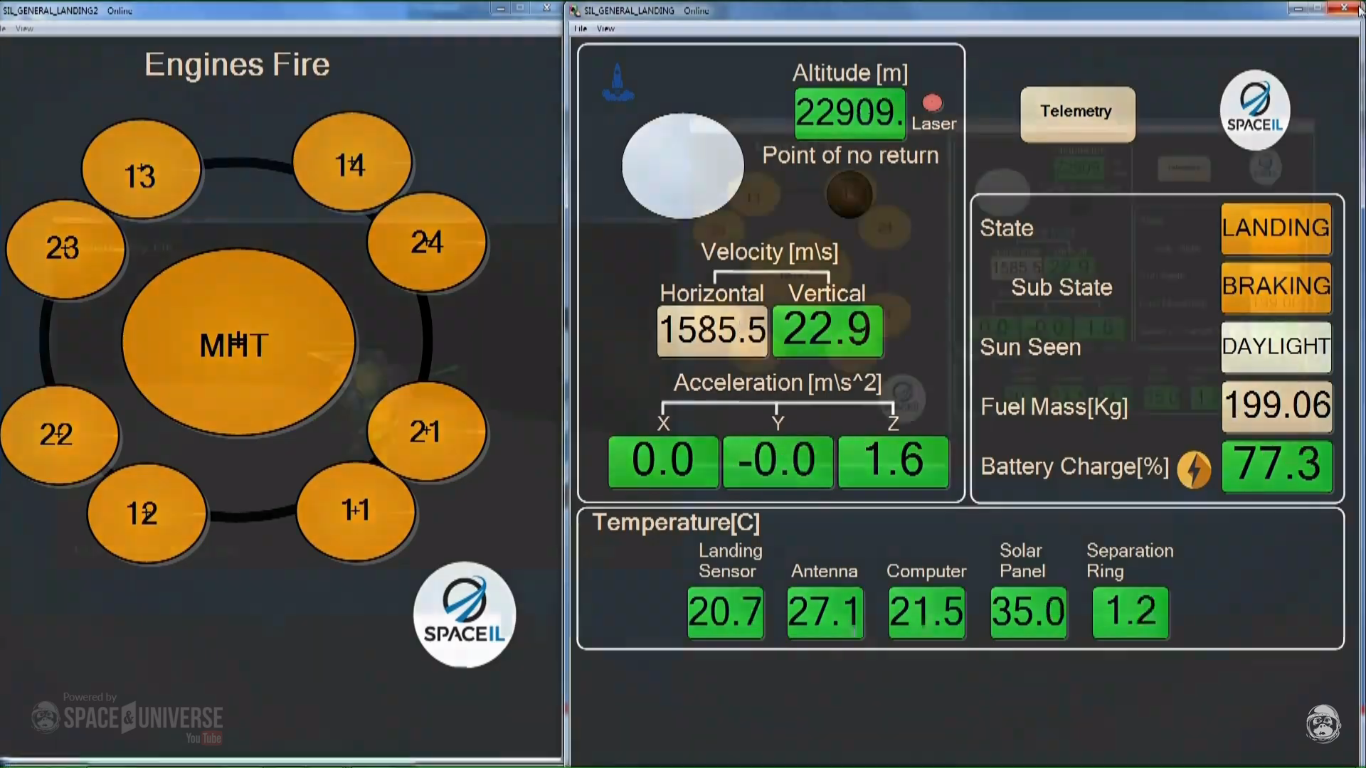
But here the problems with engine shutdown and telemetry data freezing started and abnormal readings of speeds, which at design heights should be completely different.
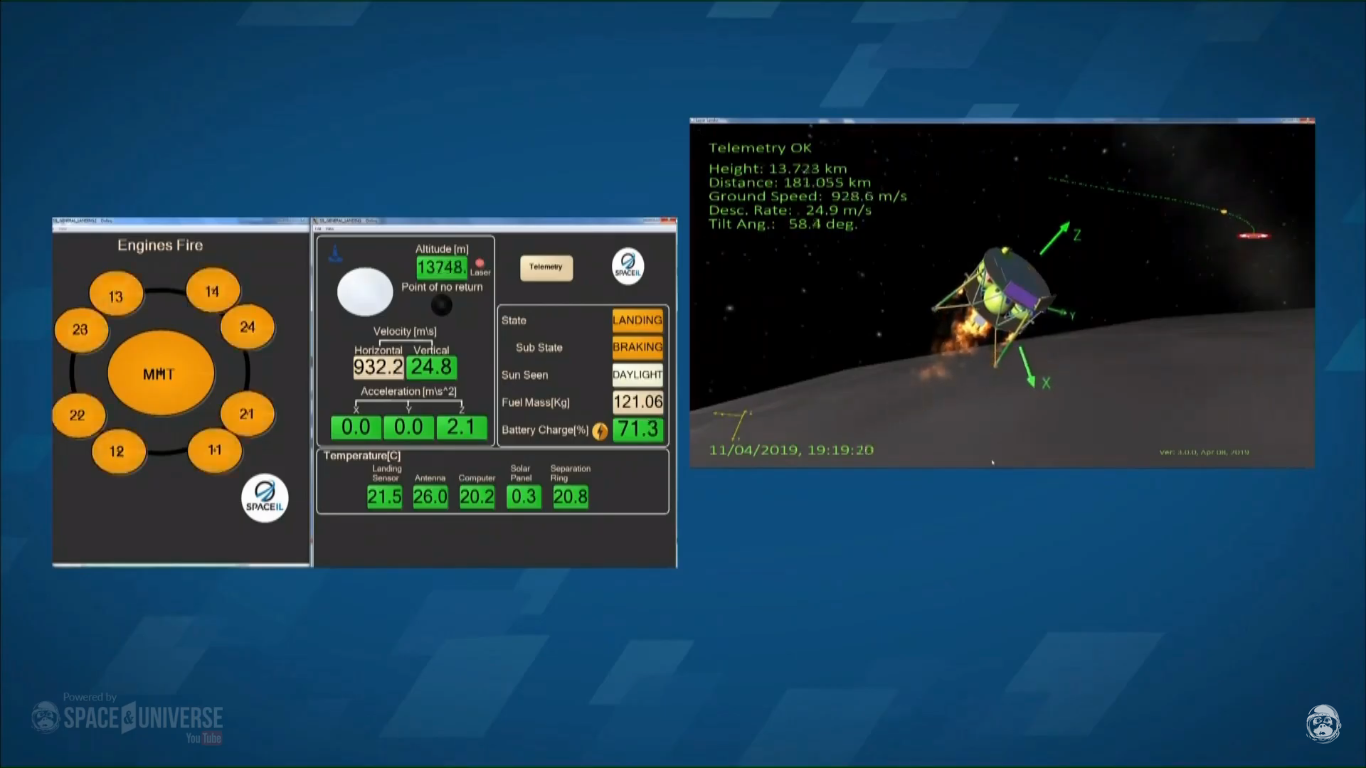
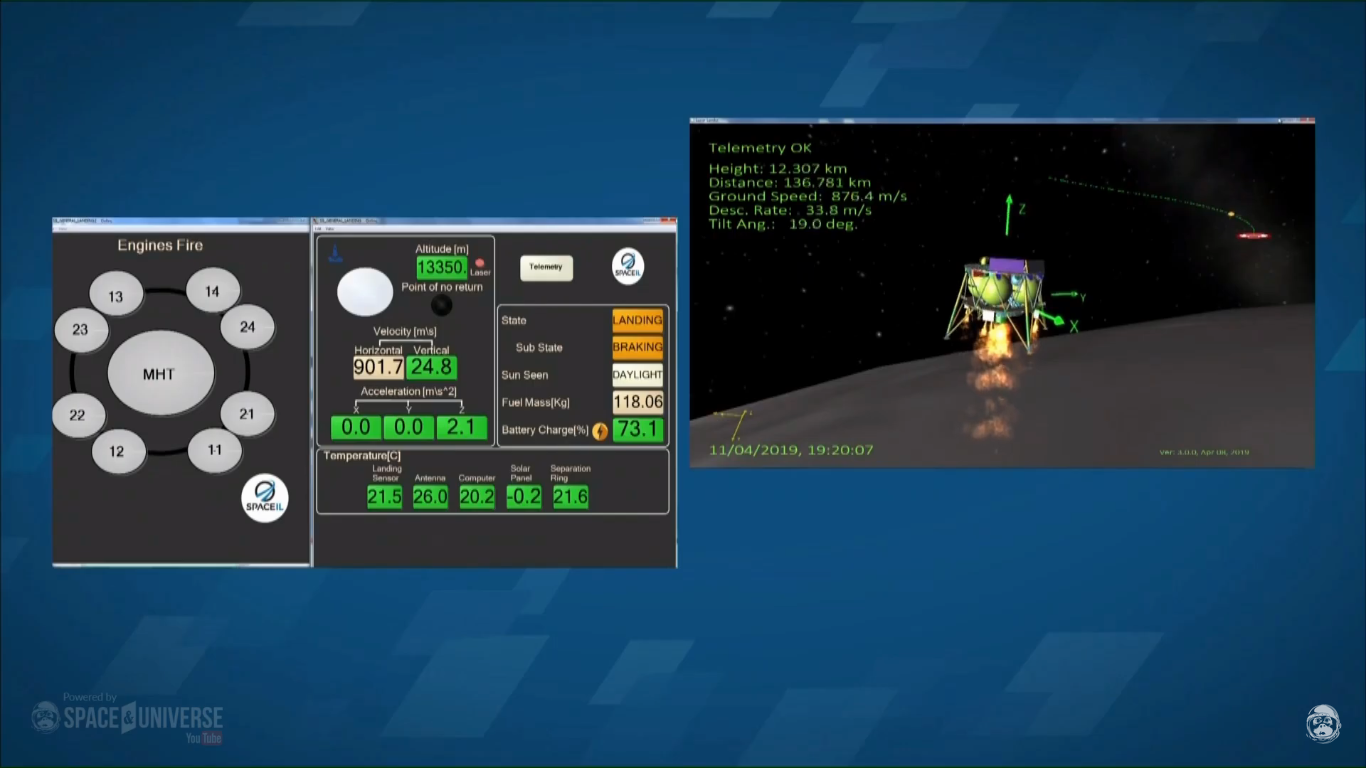





23:03 Telemetry indicator turns green. Sub State is Orientation.
25:04 Sub State changes to Braking.
25:20 “We are past the point of no return.”
25:26 The Point of No Return indicator turns black.
25:52 Vertical velocity display turns green.
28:16 Telemetry indicator is no longer green.
28:20 Telemetry indicator momentarily turns green, then is no longer green.
29.37 Distance is shown as 210 km.
29:50 Distance changes to 385 km.
30:03 Distance changes to 370 km.
30:40 Telemetry indicator is green.
30:51 Distance is 314 km.
31:33 Beresheet selfie is shown. Altitude approx 22 km ??? Telemetry is green.
31:50 Telemetry indicator is no longer green.
31:55 to 32:29 "[inaudible] kill it." "[More inaudible mission chatter] busy."
32:48 Telemetry screen is shown. Telemetry indicator is light yellow. Altitude is 14095 m. Horizontal velocity is 955.5 m / s. Vertical velocity is 24.8 m / s. Main engine is on. Horizontal velocity is light yellow. Other parameters are green, except for the telemetry indicator.
32:49 All engines are on.
32:51 All engines are off.
32:55 Main engine is on.
32:57 All engines are on.
32:59 Main engine is on. Distance is 183.8 km.
33:01 - 33:03 “IMUstein not okay.”
33:02 All engines are on.
33:05 Main engine is on.
33:07 All engines are on.
33:09 Main engine is on.
33:11 All engines are on.
33:13 Main engine is on.
33:16 All engines are on.
33:20 Telemetry indicator turns green. All engines are off. All displays remain static (no change).
33:32 Telemetry indicator is no longer green. All engines are off. All displays remain static (no change).
34:24 Telemetry indicator turns green. All engines are off, yet supposedly turn on. Vertical acceleration on the Z axis is fixed at 0.6. "We currently have a problem in one of our inertial measurement units." Vertical velocity starts to steadily increase. Altitude continues to steadily decrease. Vertical acceleration on the Z axis becomes fixed at 0.6. Main engine probably is not on.
Telemetry indicator intermittently turns green and then turns light yellow, up until the following video time stamp.
34:56 Telemetry indicator is no longer green. Although all engines are shown as on, vertical velocity continues to increase. Vertical acceleration on the Z axis remains fixed at 0.6. Main engine probably is not on.
36:25 - 36:33 “We seem to have a problem with our main engine. We are resetting the spacecraft to try to enable the engine. "
36:40 Telemetry indicator is green. All engines appear to be on, yet Z axis acceleration remains fixed at 0.6 m / s. Altitude is 678 meters. Horizontal and vertical velocities are 948.1 m / s and 130.1 m / s respectively.
36:44 Last telemetry data. Telemetry indicator is green. All engines appear to be on. Z axis acceleration changes to 0.7 m / s. Final altitude is 149 meters. Final horizontal and vertical velocities are 946.7 and 134.3 m / s respectively. Main engine does not appear to be functioning properly.
The last 4 seconds of the device’s life according to the data from the MCC (from 678 to 149 meters decrease):
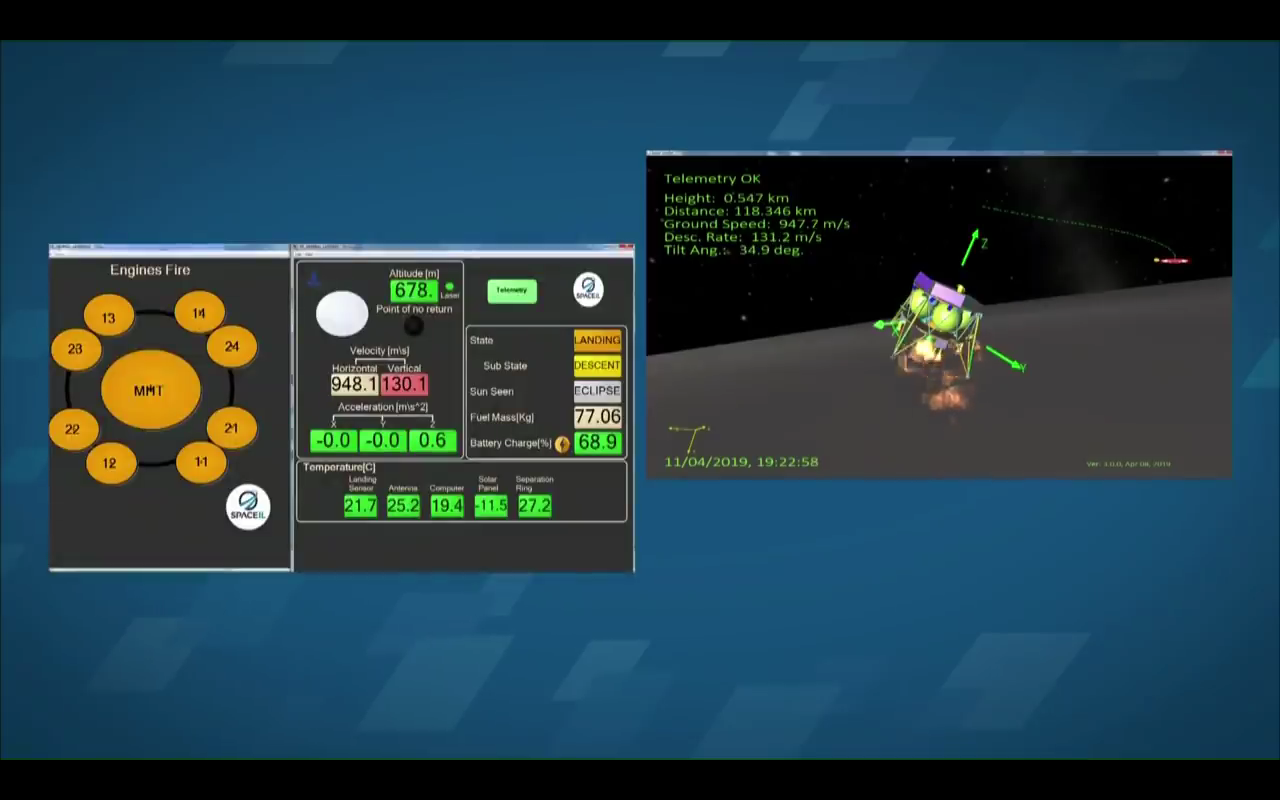
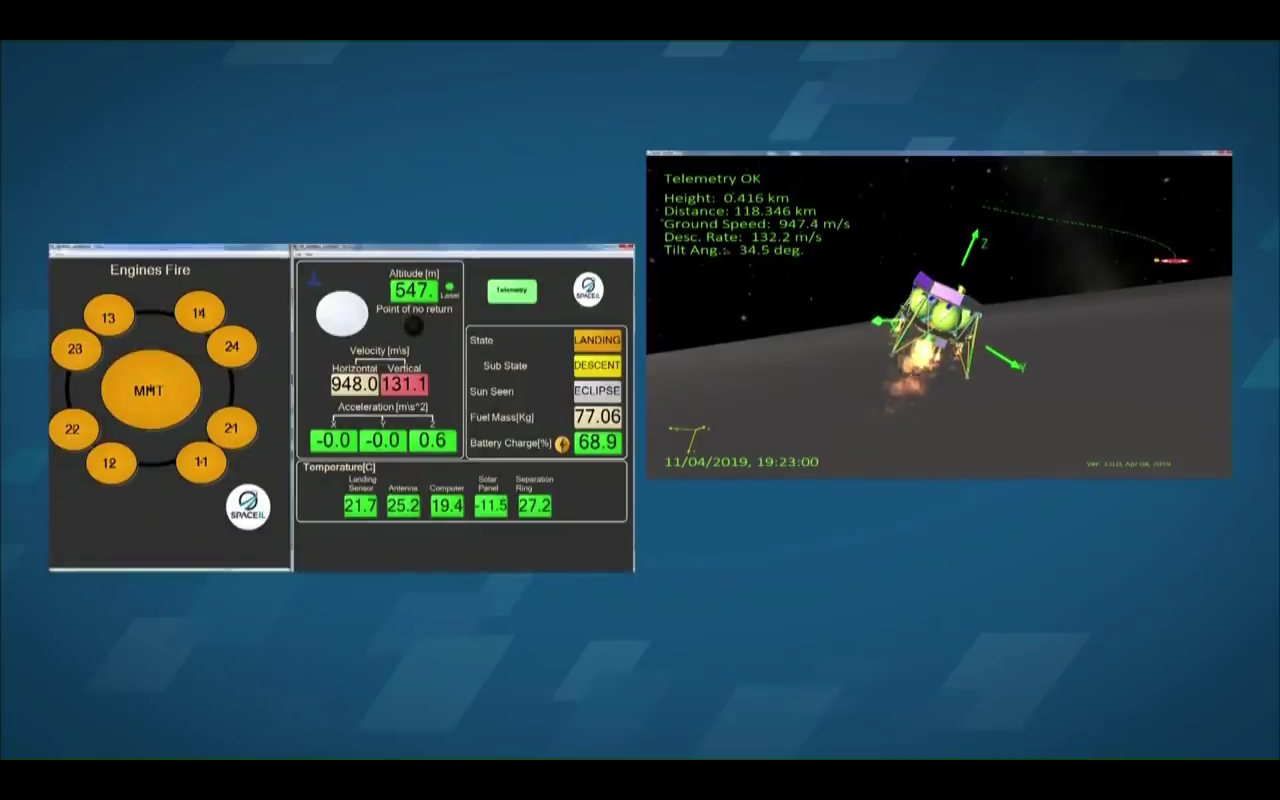
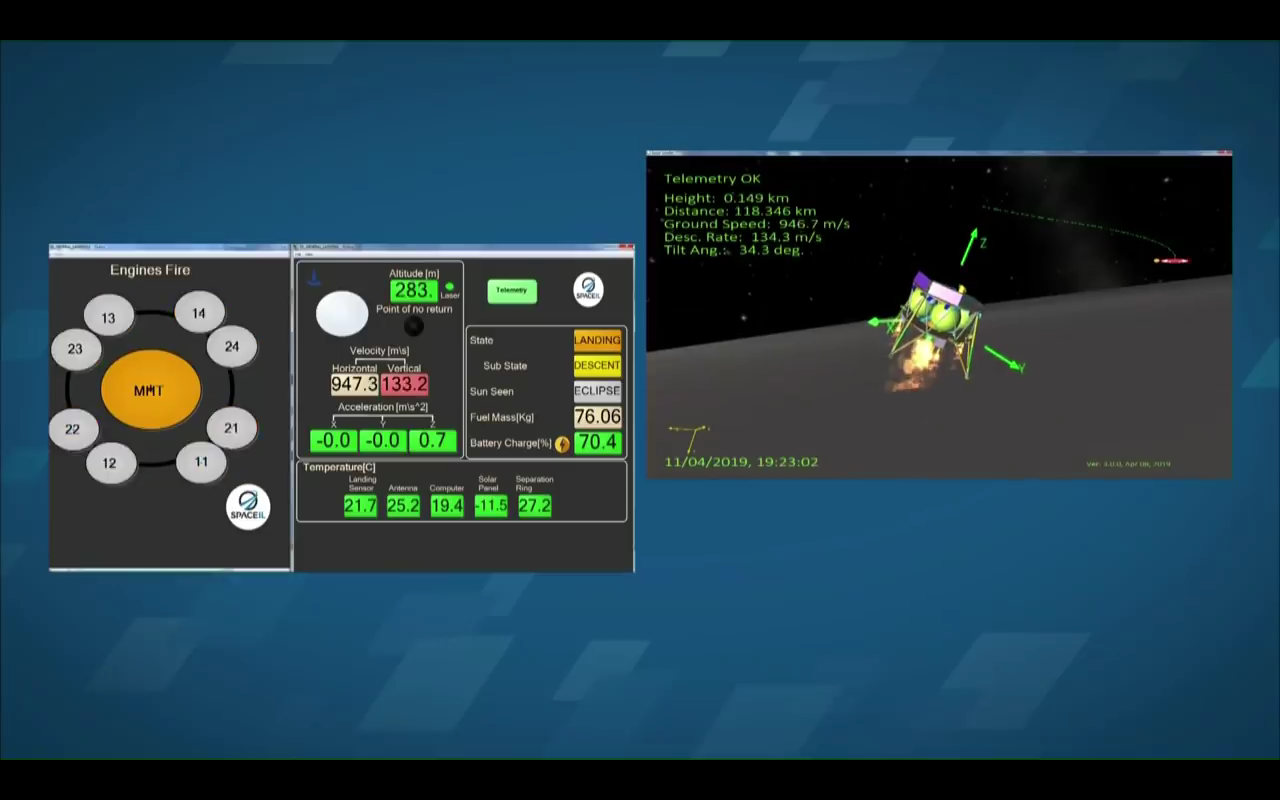

At 19:23, telemetry data completely stopped arriving.
Previously - the problems started at an altitude of 14 km, the main engine turned off during the landing process, and after it was restarted it was too late - the device could not brake correctly, this malfunction led to a hard fall at high speed and from a height of 150 meters to the moon.
Inertial orientation unit (inertial measurement unit - IMU1, IMU2) - nodes are duplicated.
But this is interesting, since here two blocks were used and their data was very important for the on-board computer.
Already earlier, because of the failures of such modules, there were accidents - as with the Schiaparelli apparatus on Mars in 2016.
It turned out that a fatal error in the operation of the Skiaparelli software occurred due to problems in the operation of the "Inertia Meter" (IMU), a device that measures the speed of rotation of the module around its axis.
Data from this device, as the engineers explain, were taken into account when processing data on flight altitude coming from the Schiaparelli radars. At one point, the IMU crashed, as a result of which it “measured” an abnormally high speed of rotation of the render, which went beyond the permissible values. Such failures are the norm in the operation of inertial sensors, and usually to suppress them, scientists “smooth out” the signal and compare data for the current moment with the results obtained at past times.
But in this case, the IMU transferred data to the Schiaparelli host computer for an unexpectedly long time, for a second, which “deceived” the module software and forced it to consider these measurements as real data, and not an anomaly. Incorrect values were taken into account when calculating the module height, as a result of which the Skiaparelli on-board computer received negative height values.
The module considered that it was not even on the surface of Mars, but under it, which forced him to initiate the final stage of the landing procedure at an altitude of 3.7 km, to separate the parachutes and turn off the engines.
The device Bereshit used the following IMU module: STIM300 .
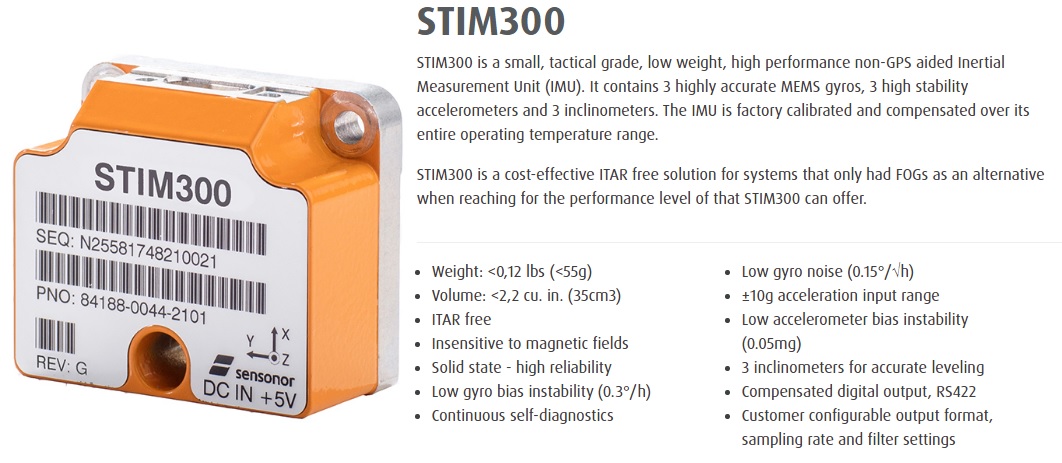
This module has low-level radiation protection characteristics, so the use of such devices on the Moon will probably be further thought out by SpaceIL engineers later on in new missions.
Since there was a statement from SpaceIL after the accident: “Problem in one of Beresheet's inertial measurement units. Ground controllers lost telemetry for a few moments but have reacquired telemetry. ”
Is it true that the Bereshit IMU module (or both modules) gave incorrect data (including the measurement of angular and linear accelerations became impossible) for the on-board computer and for what reason - this is still under investigation by SpaceIL engineers
However, for now it’s clear that the Bereshit spacecraft experienced a technical malfunction in one of the components, which led to the shutdown of the engines, which prevented the spacecraft from lowering the speed of descent to the lunar surface.
When the engines were restarted, they could no longer perform full braking, it turned out that the speed of the vehicle was too high, and the altitude to the surface of the moon was critically reduced, and a destructive collision occurred.

The last photo from the Bereshit camera is also a bit confusing. Since it shows the lunar surface 1000 km from the planned landing zone in the Sea of Clarity.
The last frame (officially published) from the Bereshit apparatus (from a height of 8 km):

Thus, it will be very difficult to find at least something from the Bereshit device, since the search area is very extensive:
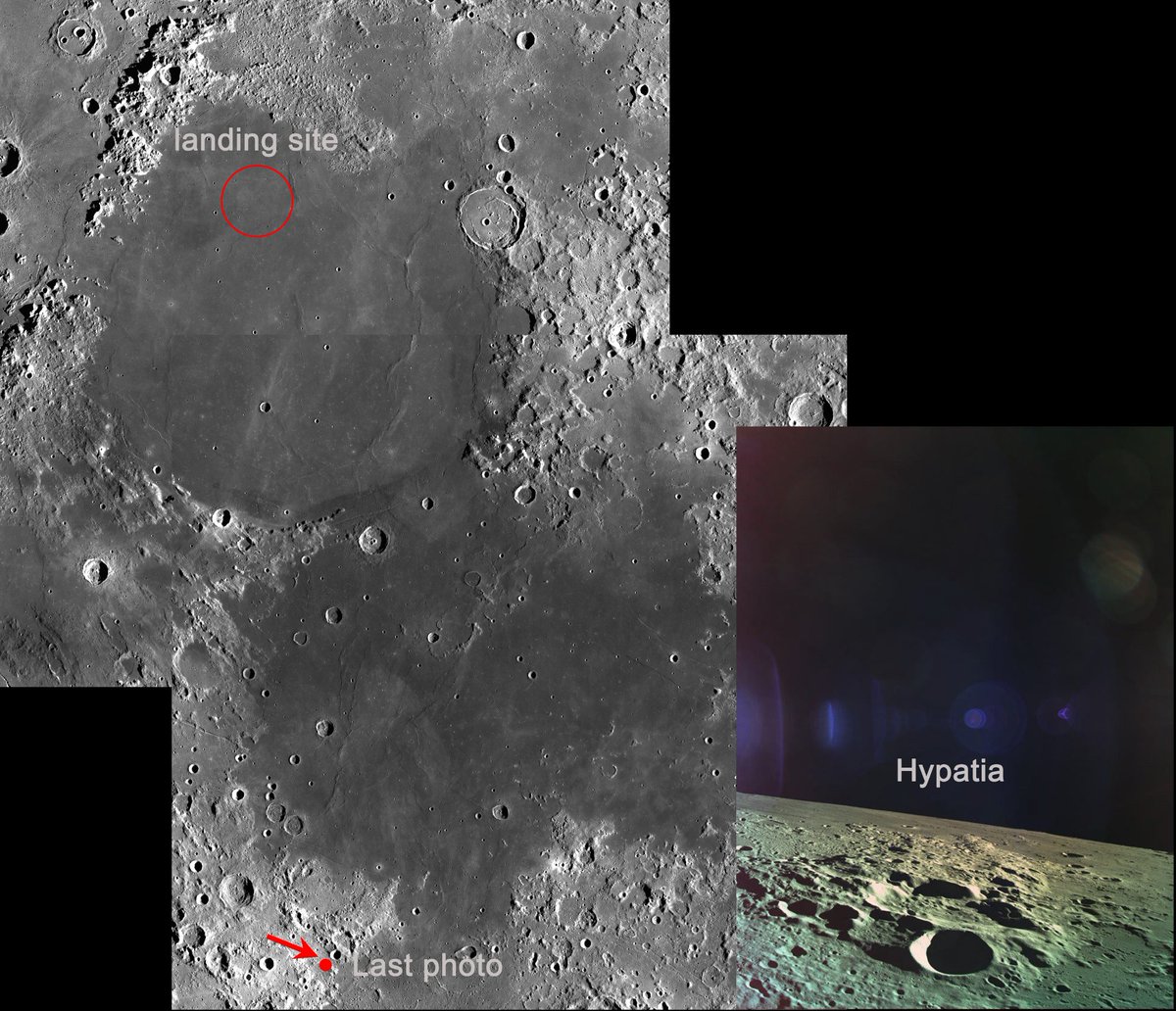
Although it’s a little clear where to look (200 km to the Apollo 11 landing zone):

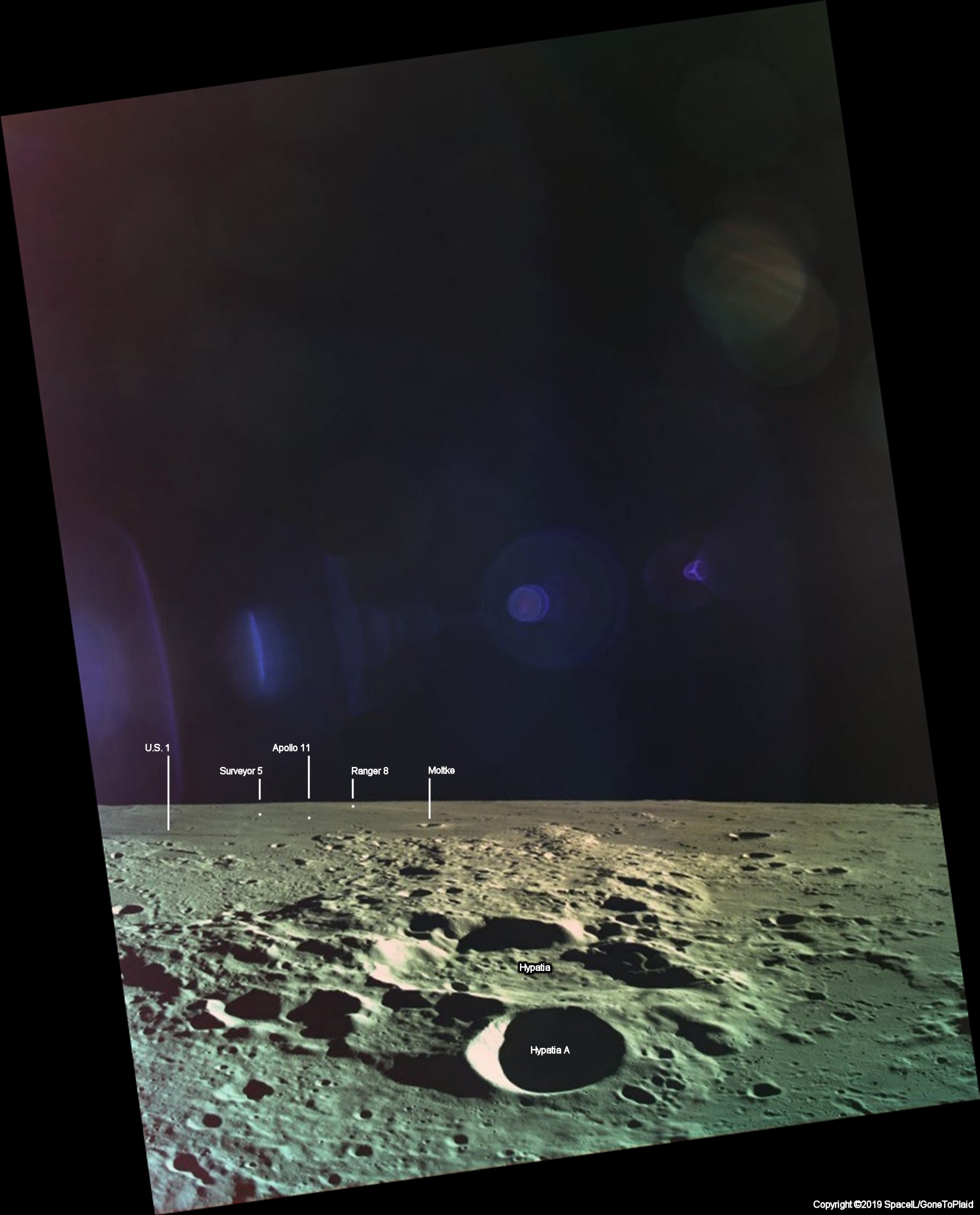
NASA plans to examine using the LRO probe the fall region of the Bereshit apparatus, in the hope that the elements of the array of laser corner reflectors have not collapsed and will be located on the surface of the moon.
Reflectors were fixed on the upper part of the device and when it fell could bounce, scatter, roll over and burrow in the lunar soil. But even if only part of the reflector is available to reflect the light pulse - this will be fixed by LRO.
A laser altimeter LRO (NASA lunar orbital probe), designed to compile altitude maps, will send laser light pulses to the corner reflector at the point of impact of the Bereshit apparatus, and then measure how long it takes for the light to go back.
Using this technique, NASA and SpaceIL engineers plan to be able to locate the remains of the Bereshit device.

Although it is also interesting here, there are still photos of the fall in SpaceIL, but they do not publish them:
- Is this really the last photo received from Beresheet? When exactly was it taken? I ask because the Hypatia crater is much more southern than the planned landing site.
- No it is not the last picture that was taken. We haveone picture that was taken closer to landing but has not been confirmed to be published yet . I assume that it will be published soon.
What will happen next with the Bereshit mission?
The development of anew space project, Bereshit 2.0, wasannounced.

Israeli Prime Minister Benjamin Netanyahu promised that the state will take part in a second attempt to send an automatic station to the moon.
“We are going to launch Bereshit-2. The State of Israel participated in the launch of the first spacecraft and will participate in the launch of the second. I hope that this time everything will be successful. In this case, we really will become the fourth country in the world to land on the moon, ”Netanyahu said at a government meeting.
It is planned that the Bereshit 2.0 project will be more serious and expensive (compared to the first), but it will still be private.
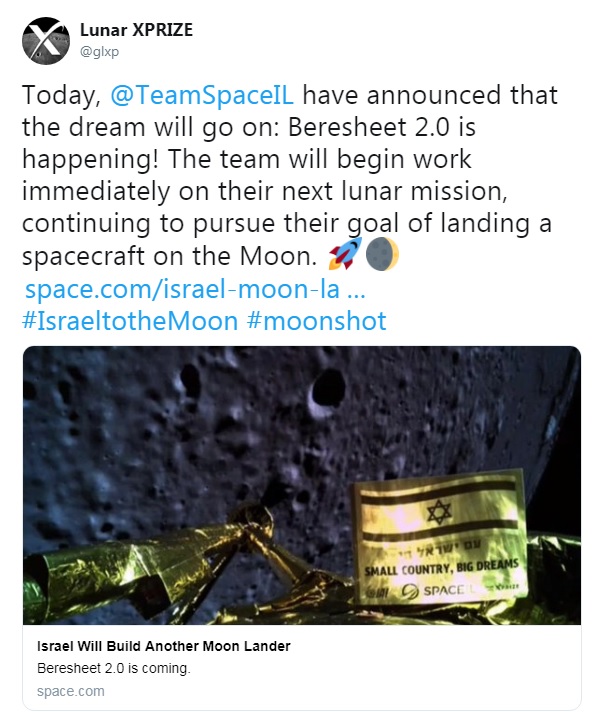
SpaceIL will also take over the main management of the new Bereshit 2.0 project and will also remain a non-profit organization.
Planned duration of the project “Bereshit 2.0”: 2-3 years.
It is wonderful when the country, engineers and people do not cease to believe in victory.

No dream is beyond your reach, if you truly want it!
And for dessert :
Lego model of Beresheet

